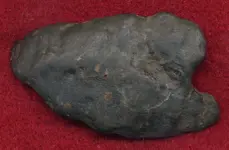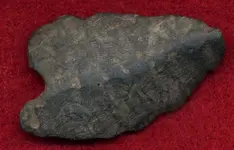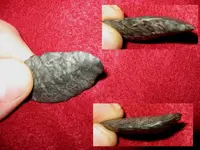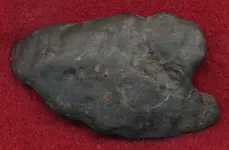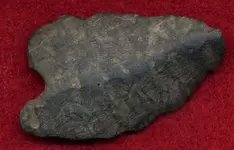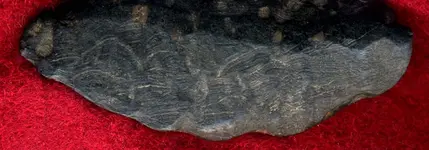You are using an out of date browser. It may not display this or other websites correctly.
You should upgrade or use an alternative browser.
You should upgrade or use an alternative browser.
Rock?? Fossil?? Arrow Head??? Tool??? What the heck is it?
- Thread starter creskol
- Start date
Some would call it an arrow head, however it appears to be a specific tool or specific design used for fishing, I would venture to say you found it in or around an old or existing river bed as it appears to be worn by water, No?
creskol
Gold Member
- #3
Thread Owner
Tuscoro said:Some would call it an arrow head, however it appears to be a specific tool or specific design used for fishing, I would venture to say you found it in or around an old or existing river bed as it appears to be worn by water, No?
The property I am hunting sits at the base of a mountain has a fast moving stream that originates up in the mountains and runs through the property. I found this buried on the bank of that stream while digging another target. Its curvature would seem to negate it from being an arrow head, so the idea o some sort of tool makes the most sense to me, and it is worn pretty smooth. Thanks!
The Grim Reaper
Gold Member
- Joined
- Apr 3, 2008
- Messages
- 7,805
- Reaction score
- 7,068
- Golden Thread
- 0
- Location
- Southern Ohio
- Primary Interest:
- All Treasure Hunting
It looks to me to be a very water worn Arrowhead. You can see some of the flake scars still visible and it has an obvious base.
Neanderthal
Bronze Member
It does look modified, the side in the second pic shows what looks to be heavy grinding. Look closely at the striations and you will see that whatever ground them down was in a circular fashion. My first impression was that somebody was using a circular tool to make pseudo flake scars. I have seen many authentic ground stone points. However, I personally have never seen an authentic "aboriginal" one done in that fashion. I have seen some that were done like that in modern times though.
MObushwhacker
Full Member
- Joined
- Feb 20, 2010
- Messages
- 102
- Reaction score
- 18
- Golden Thread
- 0
- Location
- Scott County Missouri
- Detector(s) used
- White DFX
ROCK
*Molly*
Silver Member
ldmorrill said:ROCK
I dissagree. You can see the edge work. all my blades from NC are like that but, just not so smooth looking. Its obvious that one as spent many years in water..JMHO.
I see you are in VA mine were found on the NC/ south VA boarder..
Molly.
creskol
Gold Member
- #8
Thread Owner
Neanderthal said:It does look modified, the side in the second pic shows what looks to be heavy grinding. Look closely at the striations and you will see that whatever ground them down was in a circular fashion. My first impression was that somebody was using a circular tool to make pseudo flake scars. I have seen many authentic ground stone points. However, I personally have never seen an authentic "aboriginal" one done in that fashion. I have seen some that were done like that in modern times though.
I am not seeing what you are referring to. Using a magnifying loop, all I can see is what looks like layers .. almost like looking at a topo map .. and the layers seem to follow the general contour of the piece. I can't see any circular marks? I am not disagreeing with you at all, but to my untrained eye I can't see it and hope to learn something. Thanks.
P
pickaway
Guest
Neanderthal said:It does look modified, the side in the second pic shows what looks to be heavy grinding. Look closely at the striations and you will see that whatever ground them down was in a circular fashion. My first impression was that somebody was using a circular tool to make pseudo flake scars. I have seen many authentic ground stone points. However, I personally have never seen an authentic "aboriginal" one done in that fashion. I have seen some that were done like that in modern times though.
must agree... must

creskol
Gold Member
- #10
Thread Owner
pickaway said:Neanderthal said:It does look modified, the side in the second pic shows what looks to be heavy grinding. Look closely at the striations and you will see that whatever ground them down was in a circular fashion. My first impression was that somebody was using a circular tool to make pseudo flake scars. I have seen many authentic ground stone points. However, I personally have never seen an authentic "aboriginal" one done in that fashion. I have seen some that were done like that in modern times though.
must agree... must
Here is a high resolution of the edge in question .. What circular pattern are you all seeing? Please?? Thanks
Attachments
Neanderthal
Bronze Member
The semi-circular striations on your image, look at it closely. That is generally caused from a circular implement cutting or grinding. Take a dremel rotary tool with a drum wheel on it (or any grinder really) and touch it to an object and you will get similar "groovy" results. If it's layered material then that could account for some of it, but it doesn't explain the furrows or grooves.
P
pickaway
Guest
Neanderthal said:The semi-circular striations on your image, look at it closely. That is generally caused from a circular implement cutting or grinding. Take a dremel rotary tool with a drum wheel on it (or any grinder really) and touch it to an object and you will get similar "groovy" results. If it's layered material then that could account for some of it, but it doesn't explain the furrows or grooves.
but why would someone fake a piece that looks like that? after looking at it could be a funky type of material...
Neanderthal
Bronze Member
LOL...I've seen a WHOLE lot worse fakes, trust me. You wouldn't believe the amount of pains people go through to try and produce a point. I've seen points carved out of plastic, wood, bone, shell, rubber and about everything else under the sun. I have seen hundred (yes, hundreds) of points made by people grinding down items to a form that they thought should resemble a point with flake scars.
But, I don't know that the piece is fake. I'm just throwing out ideas from what I can see from the images. It could just be the image itself that is throwing me off, sometimes things look completely different in hand. God knows I can be (and often am) wrong, but I'm receptive to any other logical ideas that someone may have about the piece.
At first I thought the piece was made of Shale, but carved and then heavily weathered. It still could be, I'm not sure. Shale is much easier to just grind than carve though, and that doesn't resemble aboriginal grinding methodology. I love pieces that make a person think, or at least take a second glance.
But, I don't know that the piece is fake. I'm just throwing out ideas from what I can see from the images. It could just be the image itself that is throwing me off, sometimes things look completely different in hand. God knows I can be (and often am) wrong, but I'm receptive to any other logical ideas that someone may have about the piece.
At first I thought the piece was made of Shale, but carved and then heavily weathered. It still could be, I'm not sure. Shale is much easier to just grind than carve though, and that doesn't resemble aboriginal grinding methodology. I love pieces that make a person think, or at least take a second glance.
Ohio_Doug
Hero Member
ldmorrill said:ROCK
I concur!
- Joined
- Dec 22, 2016
- Messages
- 2,361
- Reaction score
- 5,367
- Golden Thread
- 0
- Location
- Central NJ
- Detector(s) used
- Garrett ACE 350
Equinox 800
Eyeballs
- Primary Interest:
- Relic Hunting
Did you hear back from *Molly* from England? I'd like to learn more about blades from her. 😁
lightspirt
Sr. Member
- Joined
- Jul 26, 2023
- Messages
- 262
- Reaction score
- 109
- Golden Thread
- 0
- Location
- West Virginia
- Detector(s) used
- Spirit of the Universe
Looks like basic human nature. People talking things out.
lightspirt
Sr. Member
- Joined
- Jul 26, 2023
- Messages
- 262
- Reaction score
- 109
- Golden Thread
- 0
- Location
- West Virginia
- Detector(s) used
- Spirit of the Universe
Yes,exactly . Thats why i dont understand them being closed. If i never seen Indiane artifacts, i would be able to read people =s post and make my own determination . I would see the cloud reading stuff and flint stuff and make my own call.Isn't that what was happening in the threads you referenced as being hateful?
- Joined
- Aug 19, 2014
- Messages
- 38,987
- Reaction score
- 143,569
- Golden Thread
- 0
- Location
- Tarpon Springs
- Detector(s) used
- JW 8X-ML X2-VP 585
- Primary Interest:
- All Treasure Hunting
Petrified screwdriver handle...
lost from the first guy who used a screwdriver to recover a target.
:P
lost from the first guy who used a screwdriver to recover a target.
:P
Similar threads
- Suggestion
- Replies
- 5
- Views
- 737
- Suggestion
- Replies
- 6
- Views
- 747
- Replies
- 14
- Views
- 2K
Users who are viewing this thread
Total: 1 (members: 0, guests: 1)



